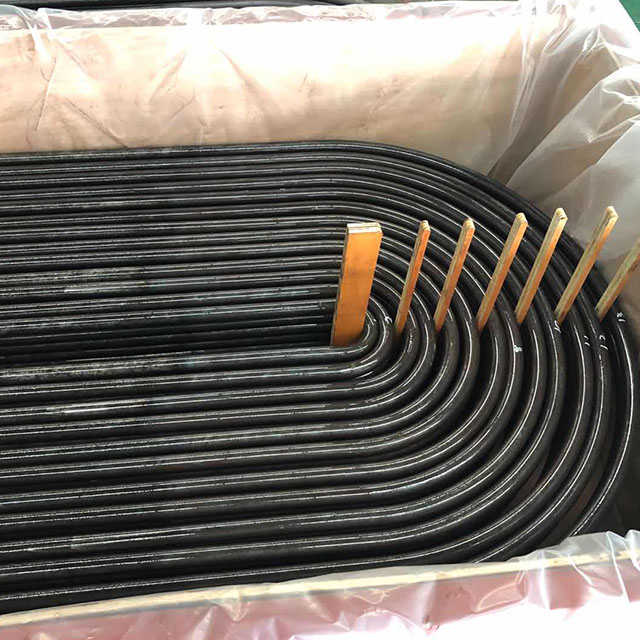Standard :ASTM A556 etc
Sizes: OD19.05 mm OD25.4mm OD 38.1mm OD50.8mm OD 63.5mm etc
Packing by Steel and Wooden boxes
Shipped by Containers or Bulk.
Product Overview
The Seamless U-Bend Industrial Tube combines the structural advantages of seamless manufacturing (no weld weak points) with the space-saving design of U-shaped bends—tailored for compact piping layouts in tight industrial spaces (e.g., heat exchanger shells, boiler fireboxes). Produced from solid steel billets via hot extrusion (followed by cold drawing for precision), it eliminates weld failures common in bent welded tubes (e.g., weld cracking from thermal cycling) and adheres to ASTM A312 standards (for seamless and welded austenitic stainless steel pipes/tubes for general service). Available in bend radii from 0.5D to 5D (D=outer diameter, e.g., 0.5D for 10mm OD tubes = 5mm bend radius) to fit custom installation requirements, with bend angles standard at 180° (U-shape) and custom angles available for non-standard layouts.

Product Features
Seamless Integrity: Manufactured via hot extrusion (at 1,200-1,300℃ for stainless steel) followed by online eddy current testing (ECT) to detect internal defects (e.g., voids, inclusions), providing uniform wall thickness (tolerance ±5%) and consistent strength across the entire bend. This avoids weld-related issues like intergranular corrosion (common in welded tubes after bending).
Precision Bending: Computer-controlled CNC bending machines (with laser angle monitoring) ensure angle accuracy of ±1° and minimal ovality (≤3% of OD)—critical for maintaining flow consistency. Post-bending stress relief annealing (at 800-900℃ for 1-2 hours) reduces residual stresses, preventing crack formation during thermal cycling.
Material Versatility: Offered in three core material groups: carbon steel (A106 Grade B for low-corrosion industrial applications), 304/316 stainless steel (for moderate corrosion, e.g., food processing), and duplex alloys (2205 for high strength + corrosion resistance, e.g., offshore oil platforms). Wall thicknesses range from 1.0mm to 28.0mm, covering small-diameter instrument lines to large-diameter boiler tubes.
Fatigue Resistance: Withstands 10,000+ thermal cycles (from -50℃ to 400℃) without cracking—tested per ASTM E290 standard—making it ideal for cyclic temperature applications (e.g., batch process reactors, where heating/cooling cycles occur daily).
Applications
Heat Exchangers: Hairpin and shell-and-tube designs in refineries (e.g., crude oil distillation heat exchangers), where U-bends eliminate the need for floating heads (reducing leakage risk) and fit within compact shell diameters.
Boiler Systems: Connecting water walls (membrane walls) and superheaters in power plant boilers, with seamless U-bends tolerating high steam pressures (up to 10 MPa) and temperatures (up to 550℃) without failure.
Chemical Piping: Compact reagent transfer lines in laboratory-scale chemical reactors (e.g., pharmaceutical API production), where space constraints require U-shaped layouts to route tubes around other equipment.
Marine Engineering: Hydraulic lines in ship engine rooms (e.g., main propulsion system hydraulics), with 316L stainless steel variants resisting saltwater corrosion and U-bends fitting within the narrow engine room space.
FAQ
Q: Does the bend compromise pressure rating?
A: No, seamless U-bends maintain 95% of straight tube pressure capacity—tested per ASME B31.1. For example, a 316L seamless tube with a straight pressure rating of 2,000 psi will have a U-bend rating of 1,900 psi, well above most industrial operating pressures.
Q: What is the maximum custom bend angle?
A: Standard angles up to 180° (U-shape), with custom angles ranging from 45° to 179° available (e.g., 90° L-bends, 135° elbow bends). Custom angles require CNC program adjustments and may have slightly tighter minimum bend radii (e.g., 1D for 90° bends vs. 0.5D for 180° bends).
Q: How does it compare to welded U-bends in cost?
A: Initial cost is 20-30% higher (due to seamless material and precision bending), but lifecycle cost is 50% lower. Welded U-bends require annual weld inspection (costing 200-500 per joint) and average 2-3 leak repairs per decade (each costing 1,000-3,000 in downtime), while seamless U-bends require minimal maintenance.


















